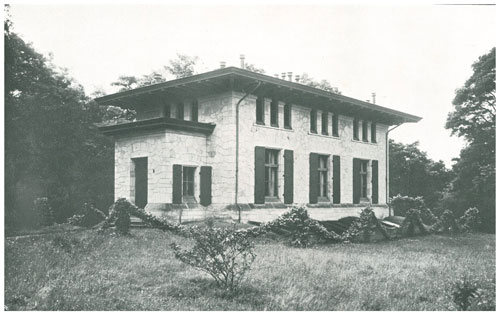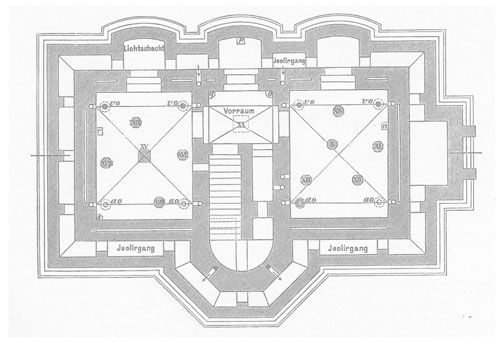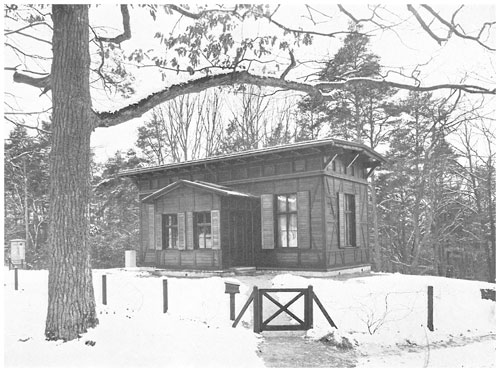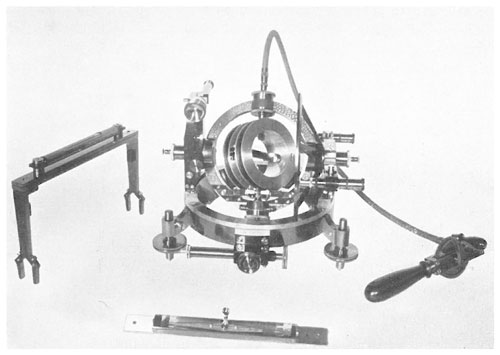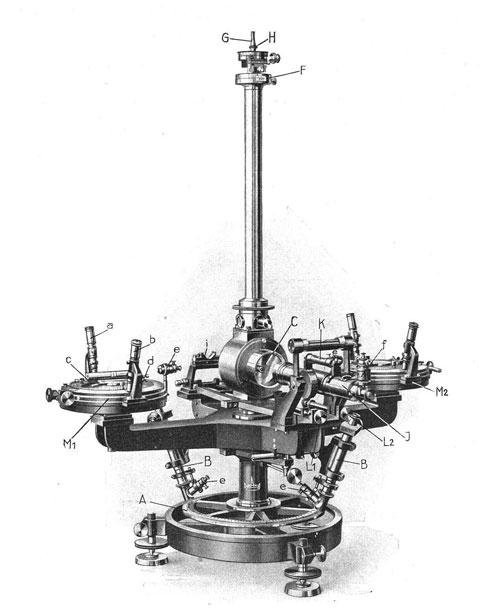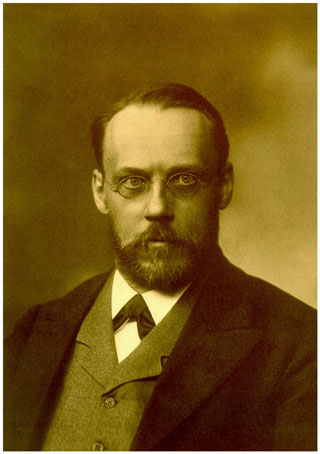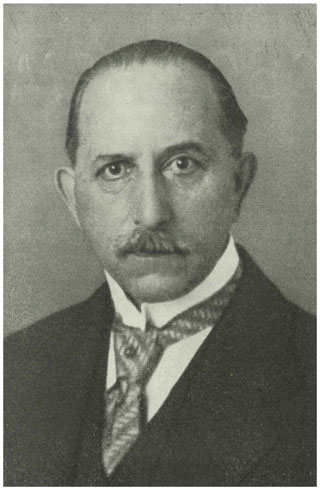the Creative Commons Attribution 4.0 License.
the Creative Commons Attribution 4.0 License.
History of the Potsdam, Seddin and Niemegk geomagnetic observatories – Part 1: Potsdam
Hans-Joachim Linthe
The measurement series of the three geomagnetic observatories Potsdam, Seddin and Niemegk spans more than 130 years, starting in 1890. It is one of the longest, almost uninterrupted series of recordings of the Earth's magnetic field. Data users frequently emphasise the high quality of the data and their significance for geomagnetic base research. Very well known outstanding geomagnetism scientists, such as Max Eschenhagen, Adolf Schmidt, Julius Bartels, Gerhard Fanselau and Horst Wiese, directed the observatories during their existence. This paper describes the history of the Potsdam Observatory, which was in operation from 1890 until 1928.
The direction of the Earth's magnetic field played an important role in navigation in ancient times. Long-term series of the recording of the declination and inclination have been available for Paris and London since the 16th century (Alexandrescu et al., 1997). Alexander von Humboldt (1769–1859) carried out several measurements of the Earth's magnetic field during his numerous travels. He encouraged Carl Friedrich Gauß (1777–1855) to apply his talent to magnetism. That Gauß did, together with his young assistant Wilhelm Weber (1804–1891), contributing greatly to the understanding of the Earth's magnetic field. In 1832, Gauß and Weber also devised a method to measure the horizontal intensity of the Earth's magnetic field. Gauß and Weber started in 1834 by setting up the “Göttingen Magnetic Union” (Göttinger Magnetischer Verein), an international network of observatories. Alexander von Humboldt stepped in by enlarging the network with the help of British and Russian authorities (Stern, 2002; Schröder and Wiederkehr, 2002).
In the framework of the Göttingen Magnetic Union, the magnetic observatories of Munich and Berlin were established. After relocation due to urban perturbations, the Munich observations were continued in Maisach and Fürstenfeldbruck, operated by the Ludwig Maximilian University of Munich (Beblo and Soffel, 1991). The Berlin observations were terminated in 1872, caused by anthropogenic noise of the city and the growing industry (Körber, 1965).
The marine geomagnetic observatory of Wilhelmshaven was operated from 1878–1911 and 1932–1934 (Voppel, 1997). It was closed due to disturbances caused by the military harbour of Wilhelmshaven. Its successor station Wingst was established in 1938 by Deutsche Seewarte Hamburg and is operated now by the Helmholtz Centre Potsdam, the GFZ German Research Centre for Geosciences.
Wilhelm Foerster (1832–1921) submitted a memorandum in 1871 proposing the establishment of a solar observatory at the Potsdam Telegrafenberg (Körber, 1965). Based on this, the Astrophysical Observatory of Potsdam was established, which was opened in 1876. In 1885 the Royal Prussian Meteorological Institute Berlin became an independent organisation under Wilhelm von Bezold's directorship (1837–1907). It was planned to establish an observatory outside of the city of Berlin exclusively for meteorologic and magnetic observations and experimental research (Hellmann, 1912). The magnetic observatory building was constructed between 1888–1889. The regular observations were started at the end of 1889. The official service began on 1 January 1890. From 1890 onward, the main building of the meteorological observatory was constructed. The former staff member of Wilhelmshaven Observatory, Max Eschenhagen (1858–1901), was appointed as the first director of the magnetic department of the meteorological magnetic observatory.
2.1 Potsdam Meteorological Magnetic Observatory buildings
The first observatory building was designed to house the absolute measurements besides the variometer recordings. The variometer recordings were located in the basement, while the absolute measurements were carried out on the first floor. All the construction materials were carefully selected. Material samples were investigated in 1887 to find out the most suitable ones with influence on the magnetic measurements later on in the building as low as possible. The belowground parts were constructed from Rüdersdorf limestone, while the aboveground parts were made from Wefensleben sandstone. Lime mortar was exclusively used as binding material. The roof with a big projection over a well-aerated loft was constructed as effective shielding against solar radiation. The basement wall of 1 m thickness is surrounded by an enclosing wall at a distance of 60 cm. This intelligent construction ensured suitably stable temperatures in the inner rooms of the building. Specially constructed, petroleum-burning heaters ensured suitable temperatures in the instrument rooms. A distance of 150 m to the main building of the meteorological observatory as well as to the domes of the astrophysical observatory prevented other influences from disturbing the magnetic measurements and recordings. Figure 1 shows the view of the observatory building from the north-east. The ground plan of the basement is shown in Fig. 2.
Already during the first years of operation of the magnetic observatory, the astrophysical observatory started the planning of a new big telescope at a distance of only 160 m. The telescope itself was about 100 t of iron, requiring a dome of 22 m inner diameter and about 150 t of iron. Due to the expectable perturbations on the magnetic measurements, a new wooden absolute house was constructed in 1897 at a distance of 260 m to the new telescope building (Brückmann, 1911). The absolute house was finished before the construction of the telescope building was started. Figure 3 shows a view of the absolute house from the north-east.
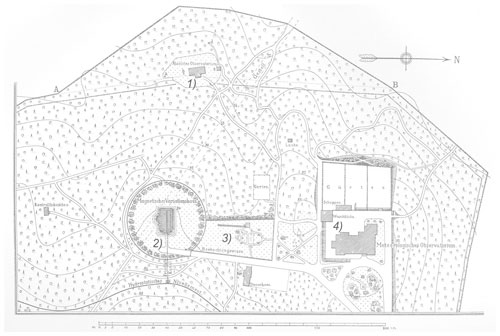
Figure 4Final ground plan of the Potsdam Meteorological Magnetic Observatory. (1) Absolute house, (2) variation house, (3) meteorological observation field and (4) main building. Source: Brückmann (1911).
The new absolute house had gas-burning heaters. The absolute measurements were carried out in this new building from 1898 onward after comprehensive comparisons with the ones in the old observatory building, which served henceforth exclusively for the variometer recordings. The old observatory building was consequently called the “variation house” from that time onward. Figure 4 shows the final ground plan of the Potsdam Meteorological Magnetic Observatory with the (1) absolute house, (2) variation house, (3) meteorological observation field and (4) main building (Hellmann, 1912).
The absolute house and the variation house were in use until 1928 for the observations. After this period, the variation house was used as a repository. It was renovated from 1998–2000 according to the regulations for historical monuments and has since then been a palaeomagnetic laboratory used by Section 4.3 of the GFZ Helmholtz Centre Potsdam. The absolute house had already become a palaeomagnetic laboratory during the 1980s. It was in use until 2000. The house still exists and is used as a repository.
2.2 Observatory instruments
Magnetic observatory data can only be achieved by combining continuous recordings of the temporal variations of the Earth's magnetic field with periodical absolute measurements. The absolute measurements are necessary to calibrate the variation instruments (variometers). The variometers were located in the basement of the observatory building (later called variation house). The absolute measurements were carried out from 1890–1897 on the ground floor of the observatory building and from 1898 onward in the absolute house.
2.2.1 Absolute measurements
According to the state of the measurement technology, the declination, inclination and horizontal intensity were determined. The declination and the horizontal intensity were measured during the first 2 years by means of the Edelmann theodolite (manufactured in Munich). The church tower of the small town of Werder at a distance of 8 km was used as an azimuth target as a reference for the true north direction. The crosshair of a permanently mounted telescope at a distance of 11.5 m inside the observatory building was further available as an azimuth target. The azimuth values of both targets were determined by means of solar observations.
An oscillation box (Wiese et al., 1960), also manufactured by Edelmann, Munich, for the measurements of the horizontal intensity also existed. By using the two independent measurement methods for the horizontal intensity, varying parameters of the deflection magnet, which was used for both methods, were eliminated. The inclination was determined first by a dip needle, manufactured by Carl Bamberg, Friedenau, near Berlin, and an Earth inductor after Leonhard Weber, made by Hartmann & Braun, Frankfurt am Main (Weber, 1885). Figure 6 shows a sketch of the Bamberg dip needle (left) and a photo of the Earth inductor after Leonhard Weber. Photos of the Edelmann theodolite and oscillation box unfortunately do not exist. The Earth inductor after Leonhard Weber still exists at the Niemegk Adolf Schmidt Geomagnetic Observatory. It is unknown what happened with the Edelmann theodolite and the Bamberg dip needle. The Niemegk Adolf Schmidt Geomagnetic Observatory owns a historic oscillation box, which can be supposed to be the Edelmann one, but it does not have any manufacturer's label.
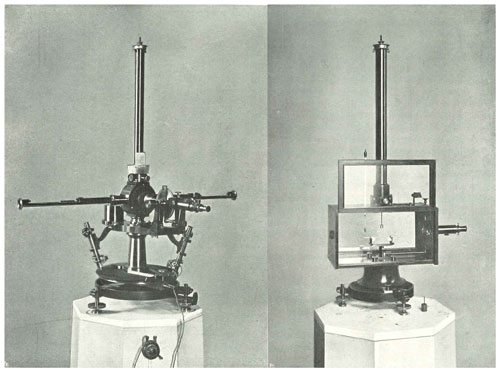
Figure 5Magnetic theodolite (left) and oscillation box (right) made by Wanschaff, Berlin. Source: Hellmann (1912).
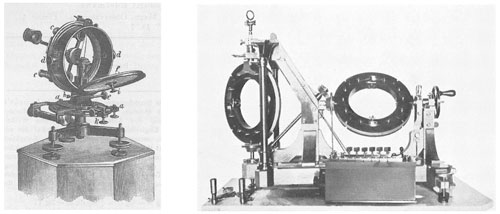
Figure 6Sketch of the dip needle by Carl Bamberg, Friedenau, near Berlin (left), and the Earth inductor after Leonhard Weber (right). Source: left – Eschenhagen (1894), right – Hellmann (1912).
Due to technical problems of the Edelmann theodolite, it was replaced in 1893 by an instrument set made by Wanschaff, Berlin, consisting of a theodolite and an oscillation box. Figure 5 shows both the instruments. In 1901 an Earth inductor following Eschenhagen's construction, made by Schulze, Potsdam, was purchased for the inclination measurements (Schmidt, 1905). Figure 7 shows this instrument. This instrument was in use until 1966, and it still exists in Niemegk.
In 1903, the observatory planned a contribution of an instrument to the 1904 world exhibition in St. Louis. For this purpose, the observatory commissioned Carl Bamberg, Friedenau, to construct a theodolite on the base of Adolf Schmidt's design. The remaining time was too short to finish the construction in time. The instrument was only handed over in 1907. Adolf Schmidt proved his theory for the horizontal intensity measurement by setting the deflection magnet by means of a turntable into different angular positions with respect to the magnetic needle of the theodolite using this instrument. In conclusion of this development, in 1927, Askania, Berlin, constructed a magnetic theodolite following Adolf Schmidt's specification (Bock and Schmidt, 1928). Figure 8 shows this instrument, which still exists in Niemegk. Adolf Schmidt's international reputation caused a huge market demand for this excellent instrument. Askania, Berlin, delivered such instruments to a large number of international observatories.
2.2.2 Variation recordings
Two different sets of variometers were operated for the observation of the declination (unifilar) and horizontal intensity (bifilar), both based on a suspended magnet, and the vertical intensity (balance) in separate rooms of the basement. The so-called main system consisted of the three instruments of Mascart's construction, made by Carpentier, Paris (Mascart, 1900), and a photographic recording unit made by Wanschaff, Berlin (Eschenhagen, 1894). For the backup system, instruments after Wild–Edelmann's construction were used with manual reading. The main system was operated in the west room of the basement. The recording unit had separate drums for the photographic paper for each variometer, running at a speed of 2 cm h−1, but only one petrol-burning light source. It was constructed following the so-called Kew pattern equipment (Gordon, 1880) considering experiences achieved at Wilhelmshaven Observatory. The average sensitivity of the unifilar was 1.09 arcmin mm−1, of the bifilar 5 nT mm−1 and of the balance 1 nT mm−1 (approximately). The baselines of the photographic recordings were interrupted hourly by 3 min as time marks, controlled by a non-magnetic pendulum clock. In Fig. 9 the photographic recordings of the declination and horizontal and vertical intensity of the time interval from 15 February 1890 12:00 to 16 February 1890 12:00 (Potsdam mean local time) are depicted as an example of the observatory variometer recordings. Figure 10 shows sketches of the main system (left) and the backup system (right).
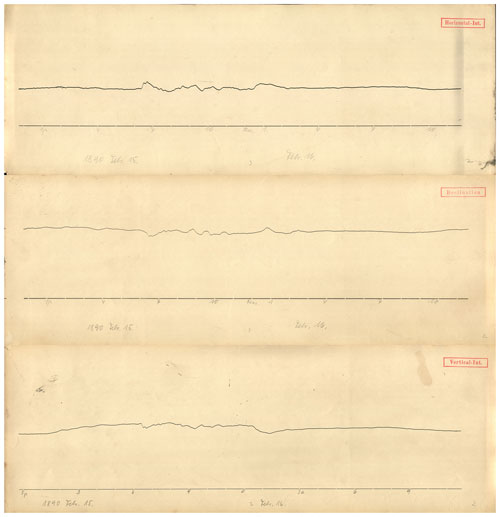
Figure 9Potsdam Observatory photographic recordings of the declination and horizontal and vertical intensity of the time interval 15 February 1890 12:00 till 16 February 1890 12:00 (Potsdam mean local time). Source: Helmholtz Centre Potsdam – GFZ.
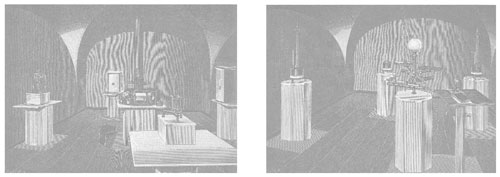
Figure 10Main recording system (left) and backup variometer system for manual reading (right). Source: Eschenhagen (1894).
In 1903 and 1904, equipment for galvanic-scale value determination was installed at all variometers of the main system and of the balance of the backup system. It was put into use regularly from 1905 onward.
2.3 Operation of the Potsdam Observatory
Every day at the same time, the photographic paper was changed and afterwards developed. Following the usual international practice, hourly instantaneous data were determined by means of distance readings between the recorded curve and the baseline manually for each component and converted into magnetic units. Finally the baseline values were added, and the results were inscribed into the final tables for the declination (D) and horizontal (H) and vertical (Z) intensity, published in the yearbooks. The manual readings taken from the backup system were regularly compared with the photographic recordings of the main system.
The time base was the mean local time of Potsdam, determined by the Potsdam Geodetic Institute.
The first magnetic yearbook, containing the results of 1890 and 1891, was published in 1894 (Eschenhagen, 1894). The following volumes were published regularly but with different delays. The volumes 1892–1900 did not contain general information, absolute measurement results and baseline values, which were published in Brückmann (1911).
Adolf Schmidt published the yearbooks containing all data and general information beginning with the volume of 1901. From 1905 onward, he published hourly mean values (Schmidt, 1908) instead of instantaneous data, as was done for 1890–1904. Gradually, all the international magnetic observatories followed Schmidt's example. At the same time, Schmidt invented Greenwich civil mean time as the time base of the observatory (Schmidt, 1908) and changed from the publication of declination (D) and horizontal (H) and vertical (Z) intensity to north (X) and east (Y) components and vertical (Z) intensity in the yearbooks.
2.3.1 Operational problems and termination
The Potsdam Meteorological Magnetic Observatory worked over many years, undisturbed by external noise. Some international stations already noticed first disturbances on their observations around 1890, mainly caused by stray currents of DC-powered electrical railways. In 1898, the impact of operating tram networks in Berlin on geomagnetic observations was investigated (Edler, 1900). As a result, the authorities of the Potsdam Meteorological Magnetic Observatory established regulations for the operation of electrical trams within a 15 km diameter protection circle around the Potsdam Observatory, mainly to abandon the use of the rails as one of the conductors. This regulation turned out to be impossibly met by the tram society from the point of view of economics, when in 1904 the town of Potsdam planned to electrify the horse tramway. Similarly, for the nearby Teltow Canal, constructed from 1900–1906, a towing by electrical locomotives was intended to be used. Therefore, the influences of leakage Earth currents on the magnetic observations seemed to be inevitable. Due to running both the rail establishments by DC power, the relocation of Potsdam Observatory seemed to be inevitable (Schmidt, 1910). It was decided to establish an additional station for variometer recordings at a location with a secure distance to the DC-powered Potsdam tramway and the Teltow Canal towing engines. The observations at Potsdam Observatory were intended to be continued as usual. Especially the absolute measurements should be performed only in Potsdam.
Due to the launch of the DC-powered service of the Berlin suburban railway system on 11 June 1928, the observatory was forced to terminate the observations step by step in the course of the year 1928 (Nippoldt, 1930). Only the inclination measurements were further performed in Potsdam, strictly only during the shutdowns of the railway service. Two companion papers on the history of the Seddin (part 2; Linthe, 2023a) and Niemegk (part 3; Linthe, 2023b) observatories are in preparation for publication in this journal.
2.3.2 Affiliation and directors of the observatory
The Potsdam Observatory was affiliated during its complete existence to the magnetic department of the Potsdam Meteorological Magnetic Observatory of the Royal Prussian Meteorological Institute Berlin. In 1919, the institute was renamed the “Prussian Meteorological Institute Berlin”.
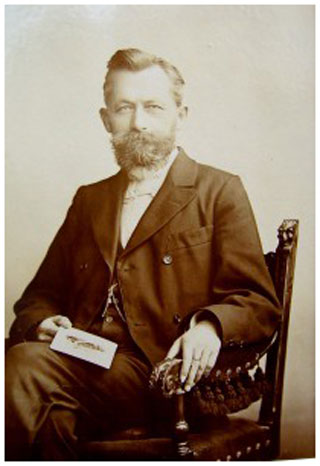
Figure 11Max Eschenhagen's portrait. Source: https://geschichte.telegrafenberg.de/personen/eschenhagen-max/ (last access: 10 February 2023) – Helmholtz Centre Potsdam – GFZ.
From 1890 until 1901, Max Eschenhagen (1858–1901) was observer, observatory director and head of the magnetic department of the Royal Prussian Meteorological Institute Berlin. Figure 11 shows his portrait. Max Eschenhagen died in 1901 at an age of only 43 years after serious disease. The famous Adolf Schmidt (1860–1944) was appointed as his successor from 1902 onward. He kept the director's position until the closing of the observatory in 1928. His portrait is shown in Fig. 12. Adolf Schmidt retired on 1 October 1928. Alfred Nippoldt (1874–1936) took over his position. Figure 13 shows his portrait.
Max Thomas Edelmann (1845–1913) was an engineer, physicist and university professor (Techn. Hochschule München) who founded the company “Physikalisch-Mechanisches Institut zur Herstellung physikalischer Präzisionsapparate” (physical–mechanical institute for the production of physical precision instruments) in Munich in 1870. He received several national and international awards for his instruments.
Carl Bamberg (1847–1892) was a watchmaker and protégé of Carl Zeiss. In 1888 he founded the “Carl Bambergs Werkstätten für Präzisions-Mechanik und Optik” (Carl Bamberg's workshops for precision mechanics and optics) in Berlin-Friedenau. Besides his magnetic instruments, he became famous for the construction of the Bamberg refractor telescope. Relatives continued the company after his death and changed the name after fusion with some other instrument-building companies in 1912 into Askania Werke AG. This company expanded the production to nautical instruments, weaponry, film cameras and projectors. They were strongly involved in producing equipment for the military in the First and Second World War. After the Second World War, the company was split into several ventures in East and West Germany.
Julius Wanschaff (1844–1903) established a workshop for precision instruments in Berlin in the 1870s. The company was inherited by Hermann Wanschaff in 1903 and absorbed into Askania Werke AG in 1922.
The paper is based on information given in the cited references. No further data were used.
The author has declared that there are no competing interests.
Publisher’s note: Copernicus Publications remains neutral with regard to jurisdictional claims in published maps and institutional affiliations.
This article is part of the special issue “History of geophysical institutes and observatories”. It is not associated with a conference.
Kristian Schlegel strongly encouraged me to write this paper. I am very thankful to him for his patience. I further thank the Helmholtz Centre Potsdam, the GFZ German Research Centre for Geosciences, which rendered it possible for me to write the paper using its resources. I am especially thankful to Jürgen Matzka, group leader of the Geomagnetic Observatories for Geomagnetism Section of the GFZ, for giving me the opportunity to work at the Niemegk Adolf Schmidt Geomagnetic Observatory. Since my official retirement at the end of 2014, I have had the chance to use an office, a computer and all the observatory publications to collect necessary information.
This paper was edited by Kristian Schlegel and reviewed by two anonymous referees.
Alexandrescu, M., Courtillot, V., and Le Mouel, J.-L.: High resolution secular variation of the geomagnetic field in western Europe over the last 4 centuries – Comparison and integration of historical data from Paris and London, J. Geophys. Res., 102, 20245–20258, https://doi.org/10.1029/97JB01423, 1997.
Beblo, M. and Soffel, H.: 150 years Earthmagnetic Observatories München-Maisach-Fürstenfeldbruck, Münchner Universitätsschriften, Münchner Geophys. Mitteil. H., 5, 11–18, 1991.
Bock, R.: Ergebnisse der Magnetischen Beobachtungen im Adolf-Schmidt-Observatorium für Erdmagnetismus Niemegk im Jahre 1934, 1–36, Magnetisches Observatorium der Universität Berlin in Potsdam, Julius Springer, Berlin, 1937.
Bock, R. and Schmidt, A.: Ein neuer magnetischer Normaltheodolit, Z. Instrumentenkd., XLVIII., 1–14, 1928.
Brückmann, W.: Ergebnisse der magnetischen Beobachtungen in Potsdam, Ergänzungsband zu den Jahrgängen 1892–1900, Veröffentlichungen des Königlich Preußischen Meteorologischen Instituts, Nr. 232, Behrend & Co., Berlin, 1–102, 1911.
Edler, J.: Untersuchungen des Einflusses der vagabundierenden Ströme elektrischer Straßenbahnen auf erdmagnetische Messungen, Elektrotech. Z., 21, 193–199, 1900.
Eschenhagen, M.: Ergebnisse der magnetischen Beobachtungen des Observatoriums in Potsdam in den Jahren 1890 und 1891, Veröffentlichungen des Königlich Preußischen Meteorologischen Instituts, A. Asher & Co., Berlin, 1–76, 1894.
Gordon, J. E. H.: A Physical Treatise on Electricity and Magnetism, vol. 1, Sampson Low, Marston, Searle, & Rivington, London, 1880.
Hellmann, G.: Das Meteorologisch-Magnetische Observatorium bei Potsdam, Veröffentlichungen des Königlich Preußischen Meteorologischen Instituts Nr. 253, Berlin, 1–69, 1912.
Körber, H.-G.: Zur Vorgeschichte der Gründung des Geomagnetischen Observatoriums Potsdam, Jahrbuch 1963 des Adolf-Schmidt-Observatoriums für Erdmagnetismus in Niemegk, Akademie-Verlag Berlin, 126–133, 1965.
Linthe, H.-J.: History of the Potsdam, Seddin and Niemegk Geomagnetic Observatories – Second Part: Seddin, Hist. Geo Space. Sci. Discuss. [preprint], https://doi.org/10.5194/hgss-2023-2, in review, 2023a.
Linthe, H.-J.: History of the Potsdam, Seddin and Niemegk Geomagnetic Observatories – Part 3: Niemegk, Hist. Geo Space. Sci. Discuss., in preparation, 2023b.
Mascart, E.: Traité de magnétisme terrestre, p. 191, Paris, 1900.
Nippoldt, A.: Ergebnisse der magnetischen Beobachtungen in Potsdam und Seddin im Jahre 1928, Veröffentlichungen des Preußischen Meteorologischen Instituts Nr. 374, Julius Springer, Berlin, 3–38, 1930.
Schmidt, A.: Ergebnisse der magnetischen Beobachtungen des Observatoriums in Potsdam im Jahre 1901, Veröffentlichungen des Königlich Preußischen Meteorologischen Instituts, A. Asher & Co., Berlin, 1–83, 1905.
Schmidt, A.: Ergebnisse der magnetischen Beobachtungen des Observatoriums in Potsdam im Jahre 1905, Veröffentlichungen des Königlich Preußischen Meteorologischen Instituts Nr. 196, Behrend & Co., Berlin, 1–82, 1908.
Schmidt, A.: Ergebnisse der magnetischen Beobachtungen des Observatoriums in Potsdam und Seddin im Jahre 1908, Veröffentlichungen des Königlich Preußischen Meteorologischen Instituts Nr. 225, Behrend & Co., Berlin, 1–97, 1910.
Schröder, W. and Wiederkehr, K.-H.: Geomagnetic research in the 19th century, Acta Geod. Geoph. Hung. 37, 445–466, https://doi.org/10.1556/AGeod.37.2002.4.8, 2002.
Stern, D. P.: A millennium of geomagnetism, Rev. Geophys., 40, 1-1–1-30, https://doi.org/10.1029/2000RG000097, 2002.
Voppel, D.: Angewandte marine Geowissenschaften – von der Deutschen Seewarte und dem Marineobservatorium über das Deutsche Hydrographische Institut zum Bundesamt für Seeschiffahrt und Hydrographie, Zur Geschichte der Geophys. in Deutschl., Hamburg, 128–133, 1997.
Weber, L.: Mittheilung über einen Differential - Erdinduktor, in: Sitz.-Ber. d. Akad. d. Wiss., Verlag der Königlichen Akademie der Wissenschaften, Berlin, p. 1105, 1885.
Wiese, H., Schmidt, H., Lucke, O., and Frölich, F.: Geomagnetische Instrumente und Messmethoden, Geomagnetismus und Aeronomie Band II, edited by: Fanselau, G., VEB Deutscher Verlag der Wissenschaften, Berlin, 1960.





